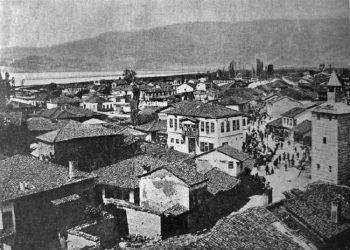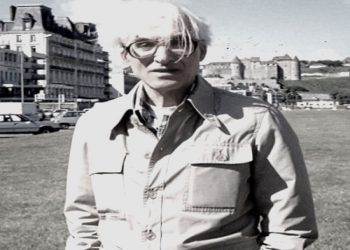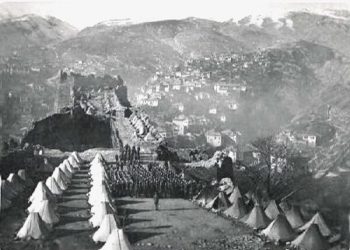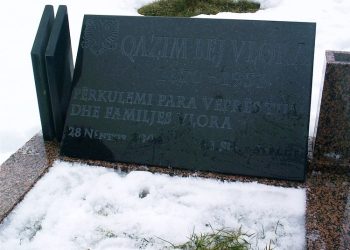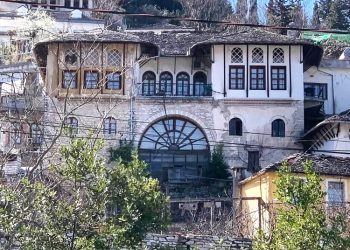Dashnor Kaloçi
Memorie.al publishes the unknown story of one of the most sensational murders in Vlora that took place in Drashovica in 1944, by the communist leaders of the Vlora District, who were ordered by Enver Hoxha. The whole painful story of Fejzo Gjomema, a former communist with the Youth Group of Anastas Lula and Sadik Premte since the time of the American Technical School of Fultz in Tirana, who did not accept the order of the communist leaders of the Vlora district to kill with assassinations, Qazim Çakërri, the commissar of the Plaka Çeta of Vlora, who was the main support of Sadik Premte. Who was the one who shot Gjomema in the back and the military career he made after the end of the War as a reward for that murder…?!
At the beginning of the autumn of 1943, by the order of Enver Hoxha, Hysni Kapo, who was one of the main leaders of the Communist Circle of Vlora, gave a verbal order to the political leader of the villages of Tragjas-Dukat-Rradhimë, Fejzo Gjomema, that he organize the assassination of Qazim Çakërri, the commissar of the Plaka Çeta of Vlora, who had become the main support of Sadik Premte and all his followers, whom Enver Hoxha called factionalists and declared traitors and enemies of the Party. Fejzo Gjomema did not carry out the order of Hysni Kapos for the murder of Qazim Çakërri, even though that order was given to him in writing according to the orders he had received from Enver Hoxha. After that, Fejzon was expelled from the Party and sent “for education” in the province of Mallakastra, in order to be physically eliminated. “But what the main leaders of the Communist Party could not do in the Mallakastra area, they did in the Drashovica War, where by their order one of the partisans shot and killed Fejzon in the back.”
The man who speaks and testifies for the first time for Memorie.al, is Sazan Gjomemo, former officer and journalist of the military press, who tells the whole story of one of the most sensational murders during the war in the area of Vlora, that of Fejzo Gjomema, his cousin, who at that time held the position of political leader of the Tragjas-Dukat-Rradhimë area and was attacked by the main leaders of the Communist Party, such as: Enver Hoxha, Hysni Kapo and Liri Gega, because he did not implement their order to assassinate Qazim Çakërri, one of the main supporters of Sadik Friday Group. Who was Fejzo Gjomema and what was his past? Where did he study, how did he connect with the communist movement and what was his activity and the tasks he performed in the Vlora District? Why was he attacked by the senior leadership of the SNP and why did he not carry out their order to kill the Commissar of the Old Vlora Squad? How was the murder behind Fejzo Gjomema carried out, who was the man who shot at him and how was that event kept secret for more than 45 years? Regarding these and others, we know his relative, Sazan Gjomemo, who before leaving Albania, has gathered many different testimonies from Fejzo’s comrades, regarding his mysterious murder. In those testimonies, those of his comrades who were eyewitnesses of those events, shed light on the truth and illuminate that macabre murder committed on the distant September 16, 1944, which to this day is still not forgotten and continues to be discussed by the inhabitants of the villages of the Vlora River.
Who was Fejzo Gjomema?
Fejzo Gjomema was born in the village of Tragjas in the district of Vlora in 1919, whence is the early origin of that family very well known throughout the province. At a very young age, Fejzo’s father Xhaferri died, a very noble man who was engaged only in agricultural work to support his family. After the death of her father, Fejzo’s mother returned to her parents and for Fejzo the weight of the pain increased even more, leaving her without any of her parents. After that, Fejzon was raised by his uncle, Selam Gjomema, who was then an officer of the Zog Monarchy, who together with his wife Sadon, took care of him as well as their children. Fejzo was also taken care of by his grandmother (the father of the father, Xhaferri) who, when he died, left a will to Selam, so that he could do everything for Fejzo. Selam Gjomema, who influenced the formation of Fejzo, was a very cultured man, as he had finished high school in St. Miter Corona of Calabria in Italy and after working for some time as a teacher in the villages of Vlora, had gone back to Italy where had graduated from the Higher Military Academy in the city of Modena. He then returned to Albania where he was appointed as an officer with the rank of captain in the Liaison branch in Tirana, where together with his son Ahmeti, he also held Fejzon, for whom he cared even more. Selam Gjomema was happy for Fejzon who was very intelligent, which he had shown since he entered school in Tragjas, where he stood out as one of the most excellent students of all his peers.
Student at Fultz School
Regarding Fejzo’s study period in Tirana, his uncle’s son Sazan Gjomema testifies: “After finishing primary and lower secondary school in the city of Vlora, with the help of our uncle Selam, Fejzua received a state scholarship to attend classes in Fultz American Technical School in Tirana.Even during the period of studies in that school where Fejzo was in the branch of Wood Processing, he was noticed by all other students for his intelligence and high correctness as in the school premises During that time, in addition to the close friends he had from Vlora, such as Sadik Premtja, Perlat Rexhepi, Selim Alimerko, Gjon Banushi, Dilaver Poçi, etc., Sadik Staveleci was also part of Fejzo’s social circle. , Qemal Stafa, Isuf Keçi, Anastas Lula with whom he was constantly associated and had a close friendship.Fezz’s American Technical School in Tirana, Fejzo graduated in the school year 1936-’37 with very good grades ë good and after its completion, he returned to the city of Vlora, where he opened a private workshop for wood processing. After working for some time in that small workshop where he could barely make a living, he closed it and left for Tirana, where he again opened a wood workshop like the one he had in Vlora. The main reason for Fejzo’s departure from Vlora, was his engagement in the Communist Youth Group, led by his closest friends such as: Sadik Staveleci, Sadik Premtja, Anastas Lula and Isuf Keçi, where he was part of the time who continued his studies at the Fultz school “, remembers Sazani, regarding his cousin Fejzo Gjomema, who was engaged with the communist movement since its creations in Tirana in 1936-’37 by the students of the Technical school, which is known otherwise and as the school of Harry Fultz.
Political leader in the villages of Vlora
At the end of November 1941, shortly after the formation of the Albanian Communist Party, Fejzo Gjomema was sent to Vlora to organize a large demonstration to be held on the occasion of the anniversary of the Declaration of Independence. In this regard, his cousin, Sazan says: “According to many testimonies that I have managed to gather from Fejzo’s comrades, who not only knew him closely, but also had a close friend, Fejzo’s departure from Tirana to Vlora was deliberate, so Hamit Keçi told me that at a time when many of the main communists in Tirana were waiting for Fejzo, who was the most theoretically prepared, to be elected to the senior leadership forums of the Party The newly formed Albanian Communist, he was transferred to Vlora Fejzo’s departure from Tirana was because he was one of the closest friends of Anastas Lula and Sadik Premtes, whom Enver Hoxha saw as opponents Fejzo did not oppose the Party’s order to go to Vlora, but instead went there and organized a large demonstration of 28 November of vi tit 1941, where he not only openly clashed with Prime Minister Mustafa Kruja, but riding on the shoulders of his two comrades, Shyqëri Alimerko and Skënder Muço, tore the Italian flag and raised the Albanian flag. In that demonstration, Fejzo Gjomema came out openly and stood out as one of the main leaders of the Communist Circle of Vlora and for this reason the Italian authorities issued an arrest warrant and imprisoned him. After being held for some time in Vlora, the Italians brought Fejzon to the Tirana prison where many of the main exponents of the communist movement were located at the time. At that time, the Communist Circle of Tirana ordered the guerrilla unit to organize the action for the conditional release of Fejzo. After Fejzo was informed of this, he simulated becoming ill and as they were sending him to be treated at the prison hospital, he was able to escape with the help of the unit’s comrades who carried out his escape action. “After that, Fejzo was forced to go back to Vlora, where at the beginning of May 1943, the Communist Circle charged him with the task of political leader for the villages of Tragjas-Dukat Rradhimë”, Sazani recalls about Fejzo’s political activity in the first years of War.
Does not follow the order of Hysni Kapos
At the end of the spring of 1943, when a part of the Vlora Communist Party headed by Sadik Premten, came out openly against the policy of terror and violence pursued by the Albanian Communist Party led by Enver Hoxha and the two Yugoslav emissaries Miladin Popovic and Dusan Mugosha , and the great rift between Fejzo and the top communist leaders began. In this regard, Sazan Gjomemo testifies: “In May 1943, Enver Hoxha went to Vlora himself to annihilate the” Faction of Sadik Friday. “The day Enver went there accompanied by Hysni Kapo and Bedri Spahiu, according to the orders he had received from “Besnik”, Fejzo was assigned special tasks to Kastriot Muço, Shyqëri Alimerkos and Hydai Bejo. , who accompanied him at that time, throughout the conversation that Enver had with Fejzo, constantly mentioned the names of Sadik Premte, Pali Terova, Qazim Çakërri, and others who were involved in the events of Tragjas at that time. In a conversation with Enver, Fejzo realized that the situation and relations between the “Factional Group of Sadik Friday” and the senior leaders of the SNP led by Enver Hoxha, had become so tense that there was no point of understanding i. Based on this, Fejzo, who was outside the two clans, tried his best to resolve the contradictions they had between them, which not only failed, but also won the hatred of both parties who saw the right in themselves. In those days, word spread throughout the area that Fejzo had been ordered by Hysni Kapo to kill Qazim Çakërri. This order was given to Hysni by Enver Hoxha and the two Yugoslav emissaries standing next to him. But Fejzo did not carry out the order even though Hysni Kapo gave it to him in writing. According to the testimony of Gjovarf Banci, Fejzua told him the reasons why he did not want to kill Qazim Çakërri, where, among other things, he said: ‘I am the political leader of the province and I have no duty to kill people whom I do not have taken up arms against the National Liberation War and partisan forces’. Likewise, Fejzo did not allow his two comrades, Thanas Gaba and Hydai Bejo, who suggested that he carry out the Party order to assassinate Çakërri. After he did not carry out that order for the murder of the commissar of Çeta Plakë, Fejzon was transferred as a simple partisan in the area of Mallakastra, ostensibly for re-education, while the real purpose of his transfer was to eliminate him physically. Before sending him to the Mallakastra area, word spread among the people that Fejzon had been expelled from the Party and all this was done to denigrate his figure. “While he himself did not know anything because he was not called and they never communicated to him the expulsion from the Party which was a fact committed”, testifies Sazan Gjomema, regarding the big rift between Fejzo Gjomemo and the senior leaders of the SNP as he did not agree to carry out their order to assassinate Qazim Çakërri.
The mysterious murder of Fejzo
Even in the province of Mallakastra, where Fejzon was allegedly sent for re-education, he did a great job, especially with the establishment of the partisan platoon in the area of Fratar, which was considered one of the most powerful strongholds of the National Front. Fejzo was then returned to the province of Tragjas in Vlora, where he had held the position of political leader. In this regard, Sazani testifies: “The main purpose of sending Fejzo to that area was to physically eliminate him. This was seen after an assassination attempt on him while he was sleeping in a cornfield, where an automatic burst of seven the bullet slammed into his jacket, but thankfully no one touched his body. At the time, word spread that he had been shot by members of Sadik Friday’s Factional Group, but it was all a fog thrown by assassins. Sadiq Friday’s faction factions had no reason to kill Fejzon because he had no account to wash with them.But what the top communist leaders did not do. dot at that time, carried out on September 16, 1943, when Fejzo was killed in the back, while the battle with the Germans in Drashovica was over.In that battle Fejzo fought with rare heroism, especially after learning about the wounding of Hysni Kapos, the leader main of a its battle. Witnesses who are still alive today told me that Fejzon had been shot in the back and that he had been shot by his comrades as the battle was over and gunfire could no longer be heard. To cover the traces of that murder it was said as if he had been shot by a German who had climbed to the minaret of the mosque, but that few people believed. All the evidence I have gathered from Fejzo’s comrades who were in that battle, it turns out that the man who carried out the order of the senior leaders of the SNP and shot at Fejzo, was the partisan MJ who after the war held several high military positions in some districts of the country. That the assassination of Fejzo Gjomema was ordered from above is also confirmed by the attitude towards him after the war, where his name was not allowed to be given to a village school and it was removed from a main road in Vlora, which they wanted to be baptized by some of his true companions. Likewise, Enver Hoxha, the man who ordered Fejzo’s assassination, never mentioned him in his memoirs, and in order to lose track of the assassination, he was left a mere martyr, while his true comrades-in-arms several times proposed him. that he would become the “People’s Hero”. This is how Sazani closes his story about the macabre murder of his cousin, Fejzo Gjomemo, one of the personalities of the anti-fascist movement in the Vlora area during the war that was eliminated by order of Enver Hoxha./Memorie.al





